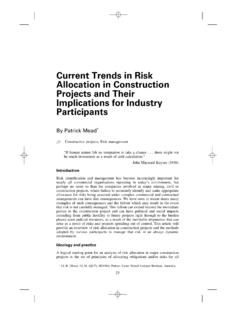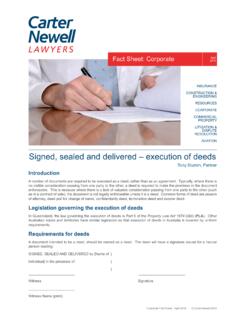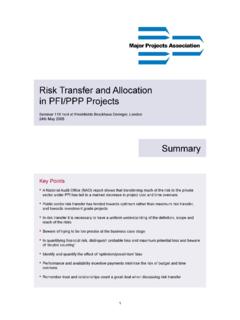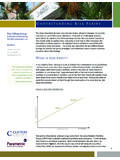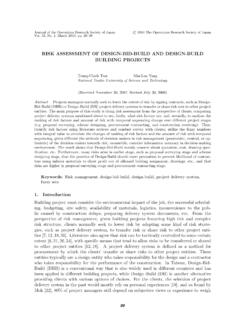Transcription of Current Trends in Risk Allocation in Construction …
1 Current Trends in RiskAllocation in ConstructionProjects and TheirImplications for IndustryParticipantsBy Patrick Mead* Construction projects; Risk management If human nature felt no temptation to take a might notbe much investment as a result of cold calculation. John Maynard Keynes (1936)IntroductionRisk identification and management has become increasingly important fornearly all commercial organisations operating in today s environment, butperhaps no more so than for companies involved in major mining, civil orconstruction projects, where failure to accurately identify and make appropriateallowance for risks being assumed under complex commercial and contractualarrangements can have dire consequences.
2 We have seen in recent times manyexamples of such consequences and the fallout which may result in the eventthat risk is not carefully managed. This fallout can extend beyond the immediateparties to the Construction project and can have political and social impactsextending from public hostility to future projects right through to the burdenplaced upon judicial resources, as a result of the inevitable disputation that canarise as a result of risks and projects spiralling out of control. This article willprovide an overview of risk Allocation in Construction projects and the methodsadopted by various participants to manage that risk in an always and practiceA logical starting point for an analysis of risk Allocation in major constructionprojects is the set of principles of allocating obligations and/or risks for all (Hons), (QUT), MIAMA; Partner, Carter Newell Lawyers Brisbane, Law Journalprojects expounded by the international Construction lawyer Max Abrahamson,referred to as the Abrahamson principles.
3 Those principles suggest that a partyto a contract should bear a risk where: the risk is within the party s control; the party can transfer the risk, through insurance, and it is mosteconomically beneficial to deal with the risk in this fashion; the preponderant economic benefit of controlling the risk lies with theparty in question; to place the risk upon the party in question is in the interests of efficiency,including planning, incentive and innovation efficiency; if the risk eventuates, the loss falls on that party in the first instance andit is not practicable, or there is no reason under the above principles,to cause expense and uncertainty by attempting to transfer the loss principles have not already translated into practice, however.
4 A study ofmajor Construction contracts for example found that: risks were not allocated to the party best able to manage the risk; formal risk assessments were not being undertaken; risk clauses varied from those in standard contracts; risks were transferred to consultants and contractors which were impos-sible for them to manage; risks were not costed in tenders; cost savings would have occurred had risks been more effectivelyallocated; the implications of changing risk Allocation were not known; disputes and claims increased as a consequence of changes to more hopeful are the results of a more recent survey concerning theusage of risk management techniques, which indicated that: the use of risk management is moderate to high, with very little differ-ences between the types, sizes and risk tolerance of the organisations,and experience and risk tolerance of the individual respondents; risk management usage in the execution and planning stages of theproject life cycle is higher than in the conceptual or termination phases.
5 1 See NPWC/NBCC report, No Dispute Strategiesfor improvement in the Australian Buildingand Construction Industry , May Australia and the Chamber of Commerce and Industry of Western Australia, EffectiveRisk Allocation in Major Projects: Rhetoricor Reality , 2001, extracted from a paper by DavidSingleton, Chair National Engineering Registration Board, Process for Resolving TechnicallyComplex Disputes .(2007) 23 Const. No. 1 Sweet & Maxwell Ltd and ContributorsCurrent Trends in Risk Allocation in Construction Projects25 risk identification and risk assessment are the most often used riskmanagement elements ahead of risk response and risk documentation; brainstorming is the most common risk identification technique used; qualitative methods of risk assessment are used most frequently; risk reduction is the most frequently used risk response method, with theuse of contingencies and contractual transfer preferred over insurance.
6 Project teams are the most frequent group used for risk analysis, aheadof in-house specialists and approachThe use of a project team to undertake risk analysis appears to be one ofthe key Trends to have emerged in recent years and it is clearly necessary totake a holistic approach that focuses not only on legal risks but the myriadtechnical, commercial, regulatory and process risks likely to be a legal risk assessment is likely to comprise only one aspect ofassessments which should be made, involving a variety of professionals drawnfrom other disciplines, both in-house and sometimes externally. The diagrambelow illustrates the types of consultants which might be engaged for riskanalysis (in the context of a PFI project process)
7 , highlighting the choices ofthe different industry of the things demonstrated by this diagram is that the risks which thevarious stakeholders consider as most significant to them will guide their focuson risk management, the Allocation of those risks and their choice of disciplinescalled upon to inform their decision-making perception of risk what constitutes a risk in the first place and thereaction of a particular party to it will often be informed by past experiencesand influenced by value systems, both personal and organisational. Hence acontractor in a competitive tendering situation may feel that it is being asked toassume risks over which it has no control, while at the same time the principalmay consider that those risks have been allocated to the party best able tomanage financier, on the other hand, its perception of risk beingdriven by the nature of the financing itself and the focus on completion risk,may seek to allocate maximum risk to the contractor for the good of cashflow insisting on an Allocation of risk even more narrow than that whichmight otherwise have been negotiated between industry managementRisk management involves the identification.
8 Mitigation and evaluation of management has been defined as the culture, processes and structures that3 Terry Lyons and Martin Skitmore, Source Project Risk Management in the QueenslandEngineering Construction Industry: A Survey , School of Construction Management and Property,Queensland University of Technology, November 5, suggested by the result of the 2001 survey conducted by the Chamber of Commerce &Industry of Western Australia and the Institution of Engineers Australia: Effective Risk Allocationin Major Projects: Rhetoric or Reality? 2001 .5 Steele A.,Audit Risk & Audit Evidence: The Bayesian Approach to Statistical Auditing,(Academic Press, London, 1992).(2007) 23 Const.
9 No. 1 Sweet & Maxwell Ltd and Contributors26 Construction Law JournalConsultants engaged for risk analysisFinancialInstitutionLegalTechnic alInsuranceFinancialConsultantConstructi onConsultantTechnicalInsuranceClientOrga nisationLegalFinancialConsultantTechnica lConstructionCompanyLegalFinancialConsul tantCostConsultantTechnicalTraffic ExpertsDesignersEnvironmentalistFMOrgani sationPlanningConsultantSurveyorsSource: Akintoye A., HardCastle C., Beck M., Chinyio E. and Asenova D., "Achieving Best Valuein Private Finance Initiative Project Procurement" (2003) 21 (5) Construction Managementand Economics TechnicalRiskConsultantDesignersSupplier sTax AdvisersFigure 1are directed towards realising potential opportunities whilst managing adverseeffects and the risk management process as the systematic application of management policies, procedures and prac-tices to the tasks of communicating, establishing the context, identifying,analysing, evaluating, treating, monitoring and reviewing risk.
10 6 While standards may specify the elements of the risk management process, theygenerally do not seek to enforce the uniformity of risk management systems andare independent of any specific industry or economic sector. Notwithstandingthis, they have increasingly formed the basis for the more sophisticated formsof risk assessment undertaken by parties to major Construction projects and setout the base parameters of the risk management :AS/NZ4360:2004, Risk Management, and 5.(2007) 23 Const. No. 1 Sweet & Maxwell Ltd and ContributorsCurrent Trends in Risk Allocation in Construction Projects27 The figure below sets out the risk management process in AND CONSULTMONITOR AND REVIEWThe External ContextThe Internal ContextThe Risk Management ContextDefine the StructureDevelop CriteriaIDENTIFY RISKSWhat can happen?
